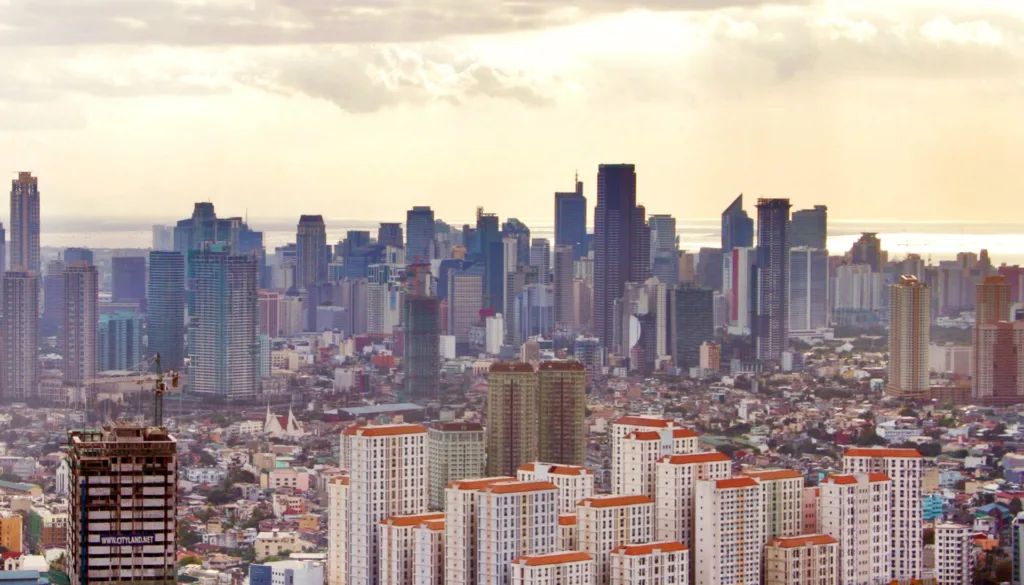1. where is Philippines :-
Philippines is, island country in Southeast Asia in the western Pacific Ocean. It is an archipelago consisting of more than 7,000 islands and islets lying about 500 miles (800 km) off the coast of Vietnam. Manila is the capital, but nearby Quezon City is the country’s most populous city.
2. capital of Philippines :-

Manila, The Philippines’ principal city and capital is Manila. The nation’s political, social, cultural, and economic life revolve around the metropolis. Spreading along the eastern shore of Manila Bay at the mouth of the Pasig River, it is situated on the island of Luzon. The nilad plant, a blooming shrub suited to marshy environments that formerly flourished abundantly along the riverbanks, is the source of the city’s original name, Maynilad.

3. What is the languages of Philippines:-
The Philippines is a multilingual country with two official languages: Filipino (based on Tagalog) and English. Filipino is the national language and serves as a lingua franca for communication among the diverse ethnic groups in the country. English is widely used for official and administrative purposes, in education, business, and in the media.
In addition to Filipino and English, there are several regional languages and dialects spoken throughout the Philippines. Some of the major regional languages include Cebuano, Ilocano, Hiligaynon (Ilonggo), Waray, and others. The linguistic diversity in the Philippines reflects the country’s rich cultural heritage and the presence of various ethnic groups across different regions.
4. What is the country code of “Philippines” :-
The country code for the Philippines is “+63”. This code is used when making international calls to the Philippines. When dialing from outside the country, you typically include the country code before the local phone number to establish the connection.
5. What is the time zone in “Philippines”:-
The Philippines follows Philippine Time (PHT), which is 8 hours ahead of Coordinated Universal Time (UTC+8). The country does not observe Daylight Saving Time, so the time offset remains constant throughout the year. Keep in mind that there might be slight variations in time within different regions of the Philippines due to factors such as local practices or geography.
6 What is the currency of Philippines :-
The official currency of the Philippines is the Philippine Peso, abbreviated as PHP or represented by the symbol ₱.
| country | currency | peso |
|---|---|---|
| United States | 1 dollar | 56.17 peso |
| united kingdom | 1 pound | 71.57 peso |
| Australia | 1 dollar | 37.07 |
| Europe | 1 euro | 61.20 peso |
| India | 1.48 Rs | 1 peso |
7. Visa requirements :-
visa requirements can change, and it’s essential to verify the most current information from official sources or the nearest Philippine embassy or consulate. However, I can provide you with a general overview of visa requirements for the Philippines:
- Tourist Visa:
- Most nationals can enter the Philippines without a visa for a short stay (usually up to 30 days) for tourism purposes. However, there are some exceptions, and the length of stay allowed may vary.
- Balikbayan Program:
- The Balikbayan Program allows former Filipino citizens and their family members to enter the Philippines visa-free for up to one year.
- Visa on Arrival:
- Some nationalities are eligible for a Visa on Arrival (VoA) or can apply for a visa upon arrival at Philippine airports. The duration of stay may vary.
- Non-Immigrant Visas:
- For those planning to stay for an extended period, non-immigrant visas are available for various purposes such as employment, business, study, and more.
- Special Visas:
- Special visas are available for specific purposes, including the Special Resident Retiree’s Visa (SRRV) for retirees, the Special Investor’s Resident Visa (SIRV), and others.
- Diplomatic and Official Visas:
- Diplomatic and official visa requirements are applicable for those representing their governments or international organizations.
Indian nationals need a valid visa to enter in Philippines, there is no visa on arrival facility for Indians.
It’s crucial to check with the nearest Philippine embassy or consulate or visit the official website of the Philippine Bureau of Immigration for the latest and most accurate information regarding visa requirements, application procedures, and any recent changes in the visa policy. Additionally, you may want to check for updates beyond my last knowledge update in January 2022.

8. Book your stay in advance :-
Book you stay in advance for hassle free vacation stay in Philippines, The Philippines is a diverse country with many beautiful destinations, and where to stay depends on your preferences and the type of experience you’re seeking. Here are some popular places to consider:
- Metro Manila:
- The capital region, Metro Manila, offers a mix of modern amenities, shopping, and cultural attractions. Makati and BGC (Bonifacio Global City) are popular business and upscale areas, while Quezon City has a lively local scene.
- Boracay:
- Known for its white sandy beaches and vibrant nightlife, Boracay is a popular destination for tourists seeking a tropical paradise. Station 1 and Station 2 are prime areas with various accommodation options.
- Palawan:
- Palawan is often considered one of the most beautiful islands in the world. Puerto Princesa, Coron, and El Nido are major attractions, each offering unique experiences, from underground rivers to stunning limestone cliffs.
- Cebu:
- Cebu is a central hub with historical sites, lively markets, and access to beautiful beaches. Cebu City and Mactan Island are popular areas for accommodation.
- Bohol:
- Bohol is known for its Chocolate Hills and unique landscapes. Panglao Island is a popular area for beach resorts and diving.
- Davao:
- Davao is located in Mindanao and offers a mix of urban amenities and natural attractions. It’s known for Mount Apo, the highest peak in the Philippines.
- Baguio:
- Located in the northern part of Luzon, Baguio is known for its cool climate, scenic views, and cultural attractions. It’s often referred to as the “Summer Capital of the Philippines.”
- Ilocos Region:
- The Ilocos Region, including Vigan, is known for its well-preserved Spanish colonial architecture.
- Siargao:
- A popular destination for surfers, Siargao is known for its laid-back atmosphere and beautiful landscapes.
- Batanes:
- The northernmost province of the Philippines, Batanes, is known for its stunning landscapes, including rolling hills and unique stone houses.
When choosing where to stay, consider the activities you want to pursue, whether it’s relaxing on the beach, exploring historical sites, or enjoying the local culture. Additionally, make sure to check recent travel advisories and safety recommendations for specific regions.
9. Organize your transport:-
Most commonly you can use local transport to get your desire destination , The most preferable transport depends on your specific needs and the nature of your travel. For short distances within a city, jeepneys, tricycles, or taxis may be suitable. For longer distances between cities or islands, buses, ferries, and flights are more common. It’s essential to consider factors such as cost, convenience, and travel time when choosing the best mode of transportation for your journey in the Philippines.
10. Safety measure’s :-
When visiting the Philippines, it’s important to prioritize your safety and take certain precautions to ensure a smooth and enjoyable trip. Here are some safety measures to consider:
- Research and Stay Informed:
- Before traveling, research the destinations you plan to visit. Stay informed about any travel advisories, weather conditions, and local news. Familiarize yourself with the cultural norms and customs of the areas you’ll be exploring.
- Secure Important Documents:
- Keep your passport, travel insurance, and other important documents in a secure and waterproof bag. Make photocopies of your essential documents and store them separately.
- Health Precautions:
- Check if any vaccinations are required before traveling to the Philippines. Bring necessary medications and a basic first aid kit. Be cautious about food and water hygiene to prevent foodborne illnesses.
- Travel Insurance:
- Purchase comprehensive travel insurance that covers medical emergencies, trip cancellations, and other unexpected events. Ensure that the coverage meets your specific needs.
- Stay Hydrated and Protect Against the Sun:
- The Philippines has a tropical climate, so staying hydrated is crucial. Use sunscreen, wear a hat, and protect yourself from the sun to avoid sunburn and heat-related issues.
- Transportation Safety:
- Choose reputable transportation options and be cautious when using public transportation. Keep an eye on your belongings, particularly in crowded places. Be cautious of pickpockets in tourist areas.
- Emergency Numbers:
- Save important contact numbers, including the local emergency services, in your phone. The emergency number in the Philippines is 911.
- Natural Disasters:
- The Philippines is prone to natural disasters such as typhoons, earthquakes, and volcanic eruptions. Stay informed about weather conditions and follow local authorities’ advice in case of emergencies.
- Cultural Sensitivity:
- Respect local customs and traditions. Be mindful of appropriate dress codes, particularly in religious or conservative areas. Avoid sensitive topics and be polite in your interactions with locals.
- Secure Accommodations:
- Choose reputable and secure accommodations. Use safes provided in hotel rooms to store valuables. Be cautious when sharing personal information with strangers.
- Stay in Designated Tourist Areas:
- Stick to well-traveled and tourist-friendly areas, especially at night. Avoid poorly lit or unfamiliar areas, and be cautious of your surroundings.
- Stay Connected:
- Keep your phone charged and have a reliable means of communication. Share your travel itinerary with someone you trust.
So that’s all about , hope you enjoyed the topic , all information collected from internet , it may have variation or some errors .
we recommend:
(Nepal)Exploring the Enchanting Beauty of Nepal: A Family Adventure
Sri Lanka tour ,Exploring the Treasures of Sri Lanka







